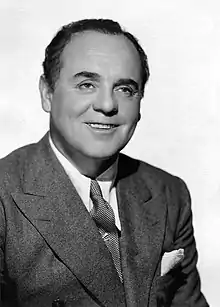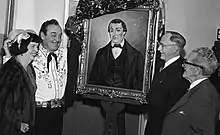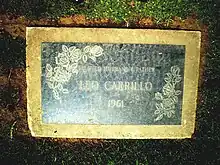Leo Carrillo
Leopoldo Antonio Carrillo (Spanish pronunciation: [ka'riʎo][lower-alpha 1]; August 6, 1880 – September 10, 1961) was an American actor, vaudevillian, political cartoonist, and conservationist.[2] He was best known for playing Pancho in the television series The Cisco Kid (1950–1956)[3] and in several films.
Leo Carrillo | |
|---|---|
 Carrillo in 1934 | |
| Born | Leopoldo Antonio Carrillo August 6, 1881 Los Angeles, California, U.S. |
| Died | September 10, 1961 (aged 80) Santa Monica, California, U.S. |
| Resting place | Woodlawn Memorial Cemetery |
| Occupations |
|
| Years active | 1915–1957 |
| Political party | Republican |
| Spouse |
Edith Haeselbarth
(m. 1913; died 1953) |
| Children | 1 |
Biography
Family roots

Leo Carrillo was a member of the Carrillo family of California, a prominent Californio family, and traced his ancestry through California, Mexico, and Spain to the year 1260.[1] His great-great grandfather José Raimundo Carrillo[4] (1749–1809), was a soldier in the Spanish Portolá expedition colonization of Las Californias, arriving in San Diego on July 1, 1769. Franciscan Friar Junípero Serra performed the marriage ceremony for Don Jose Raimundo and Tomasa Ignacia Lugo in 1781.[5][6] His great-grandfather Carlos Antonio Carrillo[4][7] (1783–1852) was governor of Alta California[8] (1837–38). His great-uncle, José Antonio Carrillo, was a three-time mayor of Los Angeles and twice married to sisters of Governor Pío Pico.[9] His paternal grandfather, Pedro Carrillo, who was educated in Boston,[10] was a writer.
Early history
The family moved from San Diego to Los Angeles then to Santa Monica, where Carrillo's father Juan José Carrillo (1842–1916), served as the city's police chief[11] and later the first mayor.[12] His cousin was Broadway star William Gaxton (real name Arturo Antonio Gaxiola). Proud of his heritage, Carrillo wrote the book The California I Love, published shortly before his death in 1961.[13]
Career
A university graduate, Carrillo worked as a newspaper cartoonist for the San Francisco Examiner, then turned to acting on Broadway. In Hollywood, he appeared in more than 90 films, often as a dialect specialist -- although in real life, he had a baritone speaking voice without a trace of an accent. He usually used the dialect for comic effect, liberally salting his speech with malaprops: "My ears, they are para-loused!" or "Why you wanna put your dirty face in my horse's water? I got a healthy horse and you put Germans in the water!" When his screen character left any scene, Carrillo always exclaimed, "Let's went!"


Leo Carrillo could play sympathetic and villainous roles with equal skill. In 1951 he took the starring role in the feature film Pancho Villa Returns, which was filmed in both English-dialogue and Spanish-dialogue versions. However, he is best remembered as Pancho, good-natured sidekick of The Cisco Kid, opposite Duncan Renaldo as Cisco. Renaldo and Carrillo were teamed for a series of feature films in 1949, and then for a syndicated television series that ran from 1950 until 1956. The Cisco Kid was notable as the first TV series filmed in color.[14] After The Cisco Kid ended production, Carrillo appeared in the episode "Rescue at Sea" of the syndicated military drama Men of Annapolis.
Civic contributions
Carrillo was a preservationist and conservationist of long standing. When a film crew did location filming in Hilo, Hawaii in 1933, the city named one of its stately banyan trees in Carrillo's honor; the "Leo Carrillo tree" still stands there today.
Carrillo served on the California Beach and Parks commission for 18 years[2] and played a key role in the state's acquisition of Hearst Castle at San Simeon, Los Angeles Arboretum, and Anza-Borrego Desert State Park. He eventually was made a goodwill ambassador by the California governor at the time.
As a result of his service to California, west of Malibu, California on CA-1 Pacific Coast Highway, a 1.5-mile beach is named Leo Carrillo State Park in his honor. The City of Westminster, California named an elementary school for him. Leo Carrillo Ranch Historic Park, originally Rancho de los Kiotes, in Carlsbad, California, is a registered California Historical Site.[15] Rancho Carrillo Trail, also in Carlsbad, is named for Leo Carrillo.[16]
Political views
In the early days of World War II, Carrillo advocated for the removal of all Japanese Americans from the west coast.[17] In a telegram to Congressman Leland Ford that received extensive coverage, Carrillo wrote:
I travel every week through a hundred miles of Japanese shacks on the way to my ranch, and it seems that every farmhouse is located on some strategic elevated point. Let's get them off the coast and into the interior. You know and I know the Japanese situation in California. The eastern people are not conscious of this menace. May I urge you in behalf of the safety of the people of California to start action at once.[18]
Carrillo was a Republican. In 1944, for instance, he performed a "Wild West" act at the massive rally organized by David O. Selznick in the Los Angeles Coliseum in support of the Dewey-Bricker ticket as well as Governor Earl Warren of California, who became Dewey's running mate in 1948 and later the Chief Justice of the United States. The gathering drew 93,000, with Cecil B. DeMille as the master of ceremonies and with short speeches by Hedda Hopper and Walt Disney. Among the others in attendance were Ann Sothern, Ginger Rogers, Randolph Scott, Adolphe Menjou, Gary Cooper, Edward Arnold, William Bendix, and Walter Pidgeon.[19]
Personal life
In 1913, Carrillo married Edith Shakespeare Haeselbarth of Nyack, New York, whom he met backstage at the New York City theater where she had seen him perform. They remained together until her death in 1953. They lived in Los Alisos on Channel Road, in Santa Monica Canyon. The Carrillos had one child, a daughter, Marie Antoinette. They spent part of their time at their 4,500-acre (1,800 ha) ranch in Carlsbad, California. Carrillo frequently permitted Boy Scout groups to camp on the grounds.[20][21]
Death

Leo Carrillo died of cancer in 1961 at the age of 81 and is interred at Santa Monica's Woodlawn Memorial Cemetery.
Legacy
For his contributions to the film industry, Leo Carrillo has a motion pictures star on the Hollywood Walk of Fame at 1635 Vine Street, and a second star at 1517 Vine Street for his work in television.[22][20] The star inspired the name of the character Horatio Carillo in the Netflix drama Narcos.[23]
Filmography
See also
- Rancho De Los Kiotes (Leo Carrillo Ranch Historic Park)
- Leo Carrillo State Park
Notes
Footnotes
- Carrillo's autobiography phonetically spelled what his family considered the correct Castilian pronunciation: "The name is pronounced "Cay-reel-yo"' with a liquid Castilian double "l". It is not pronounced "Care-reeyo" with the "y" for double "l" as in Mexico. The Mexican adaptation of Spanish is a beautiful variation in itself, but we of Castilian lineage prefer the original liquid sound for the double "l". It is part of our heritage."[1]
Mark Anthony Carrillo Sr Born July 13, 1982 the relative of Leo Carrillo
Citations
- Carrillo 1961, p. 15.
- "Leo Carrillo SP State Park". www.parks.ca.gov. Retrieved April 16, 2010.
- "'Cisco Kid' in Top Kid Spot", Billboard, April 30, 1955, p. 8.
- "José Raimundo Carrillo (1749-1809)". sandiegohistory.org. Retrieved April 16, 2010.
- Carrillo 1961, p. 17.
- "Leo Carrillo biography". Leocarrillo.net. Archived from the original on October 7, 2011. Retrieved April 3, 2012.
- "PIO PICO GENEALOGY DATABASE". www.piopico.org. Archived from the original on January 5, 2009. Retrieved April 16, 2010.
- Carrillo 1961, pp. 60, 106.
- Carrillo 1961, p. 16.
- Carrillo 1961, p. 115.
- Carrillo 1961, p. 39.
- "Santa Monica". www.worldvisitguide.com. Retrieved April 16, 2010.
- "Leo Carrillo The California I Love". film.virtual-history.com. Retrieved April 16, 2010.
- Billboard, 24 Sep 1949. Page 47.
- "Leo Carrillo Ranch Historic Park". Leocarrilloranch.org. August 26, 2011. Retrieved April 3, 2012.
- Rancho Carrillo Trail Archived 2011-09-26 at the Wayback Machine Retrieved 2012-03-30.
- Harrington, Joseph D. (1979). Yankee Samurai: The Secret Role of Nisei in America's Pacific Victory. Detroit, Michigan: Pettigrew Enterprises, Inc. p. 47.
- Masaoka, Mike (1987). They Call Me Moses Masaoka: An American Saga. William Morrow and Company. p. 60.
- David M. Jordan, FDR, Dewey, and the Election of 1944 (Bloomington and Indianapolis: Indiana University Press, 2011), p. 231
- "Hollywood Star Walk Leo Carrillo". Los Angeles Times. Retrieved March 30, 2012.
- Williams, Whitney (November 25, 1934). "A Son of the Dons". Oakland, CA: Oakland Tribune. p. 61. Retrieved July 25, 2016 – via Newspapers.com.
- "Hollywood Walk of Fame - Leo Carrillo". walkoffame.com. Hollywood Chamber of Commerce. Archived from the original on January 12, 2018. Retrieved February 11, 2018.
- Bond, Jeff (2018). The Art and Making of Narcos. Titan Books.
References
- Carrillo, Leo (1961). The California I Love. Prentice Hall. OCLC 657077014.
- José Raimundo Carrillo (1749-1809) Leo Carrillo biography
- PIO PICO GENEALOGY DATABASE
- Santa Monica |title=Leo Carrillo The California I Love
- Billboard, 24 Sep 1949. Page 47.
- Leo Carrillo Ranch Historic Park
- Rancho Carrillo Trail
- David M. Jordan, FDR, Dewey, and the Election of 1944 (Bloomington and Indianapolis: Indiana University Press, 2011), p. 231
- [http://projects.latimes.com/hollywood/star-walk/leo-carrillo/ Hollywood Star Walk Leo Carrillo cuzin to
- Mark Anthony Carrillo is related to Leo Carrillo/San Gabriel ]
External links
- Works by or about Leo Carrillo at Internet Archive
- Leo Carrillo at the Internet Broadway Database
- Leo Carrillo at IMDb
- Leo Carrillo at the TCM Movie Database
- Leo Carrillo Ranch Historic Park
- Friends of Carrillo Ranch
- Community of Rancho Carrillo - Riverside County
- The Colt Revolver in the American West—Leo Carrillo's Single Action Army